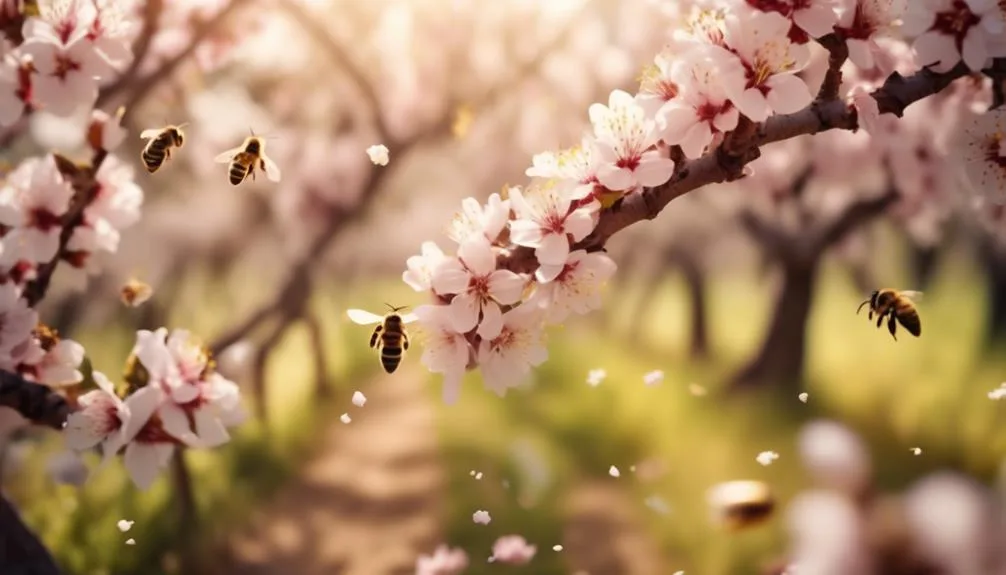Almond trees are a crucial part of agriculture with their beautiful pink and white blossoms.
But are they good for pollinators?
The relationship between almond trees and pollinators is more complex than you might think.
Let's explore how these iconic trees impact the lives of the creatures that depend on them.
Key Takeaways
- Almond trees provide a vital habitat for a diverse array of pollinators, including bees, butterflies, and other insects.
- Almond tree nectar is rich in sugars and essential nutrients, while almond tree pollen is abundant and protein-rich, making almond trees an invaluable resource for pollinator health.
- Almond tree blossoms attract bees, butterflies, and hummingbirds for nectar and facilitate pollination, supporting pollinator foraging, honey production, and bee nutrition.
- Inviting a diverse array of pollinators to almond orchards, such as honeybees, bumblebees, mason bees, and butterflies, enhances tree health and productivity.
Almond Trees as Pollinator Habitats
Almond trees provide a vital habitat for a diverse array of pollinators, supporting the dynamic ecosystem of the surrounding agricultural landscape.
The trees' blossoms are a crucial food source for bees, including the commercially managed honeybees brought in to pollinate the almond orchards. However, it's not just honeybees that benefit from almond trees. Wild bees, butterflies, and other insects also thrive in this environment.
By providing a varied and abundant food source, almond trees play a significant role in pollinator conservation. This, in turn, contributes to the biodiversity benefits of the surrounding area.
The presence of diverse pollinators ensures the successful pollination of not only almond trees but also other flowering plants in the region, supporting a rich and varied ecosystem.
Almond Tree Nectar and Pollen
Nurturing a diverse array of pollinators, the nectar and pollen of almond trees serve as essential sources of sustenance within the agricultural landscape, supporting the flourishing ecosystem of the surrounding area.
Almond tree nectar has a complex composition, rich in sugars such as sucrose, glucose, and fructose, providing vital energy for a variety of pollinators. The nectar also contains amino acids, organic acids, and essential oils, offering a well-rounded nutritional source for bees, butterflies, and other insects.
Additionally, almond trees are prolific pollen sources, producing abundant and protein-rich pollen grains. These grains are collected by bees and other pollinators, serving as a crucial protein source for their larvae.
The combination of nutrient-rich nectar and protein-packed pollen makes almond trees an invaluable resource for supporting the health and vitality of pollinator populations.
Almond Tree Blossom and Pollination
With the arrival of spring, almond tree blossoms burst forth in a breathtaking display of delicate, fragrant flowers, heralding the start of the crucial pollination process. As the almond tree bloom season begins, it becomes a hub of activity for various pollinators. Here's what you might witness:
- Busy bees darting from flower to flower, collecting nectar and transferring pollen to facilitate the fertilization of almond blossoms.
- Butterflies gracefully flitting among the blossoms, sipping nectar and inadvertently aiding in the cross-pollination of almond trees.
- Hovering hummingbirds, attracted by the sweet nectar of the almond blossoms, play a significant role in pollination as they move from bloom to bloom.
The almond tree's blooming period not only supports pollinator foraging but also contributes to honey production and serves as a vital source of nutrition for bees during this critical time.
Almond Orchards and Pollinator Diversity
Inviting a diverse array of pollinators to your almond orchard can enhance the health and productivity of your trees. By promoting biodiversity, you create a thriving ecosystem that supports the pollination process. Honeybee foraging in almond orchards not only benefits the almond trees but also contributes to the overall biodiversity of the area. Here's a glimpse of the biodiversity benefits of inviting various pollinators to your almond orchard:
| Pollinator | Biodiversity Benefit |
|---|---|
| Honeybees | Efficient pollination |
| Bumblebees | Diverse pollination |
| Mason Bees | Consistent pollination |
| Butterflies | Additional pollination |
The presence of these pollinators not only aids in the almond trees' productivity but also creates a visually appealing and lively environment in your orchard.
Almond Tree Management for Pollinators
To optimize the presence and activity of pollinators in your almond orchard, implementing effective almond tree management practices is essential for ensuring a healthy and flourishing environment. Consider the following key practices:
- Almond Tree Pruning: Regular pruning helps maintain the health and structure of almond trees, ensuring better access to sunlight and airflow. This promotes the growth of more flowers and facilitates pollinator movement across the orchard.
- Pollinator Forage: Encourage the presence of pollinators by planting diverse, nectar-rich flowering plants around the orchard. This provides essential forage for pollinators, supporting their populations and activity.
- Habitat Restoration: Create and maintain natural habitats within the orchard, such as hedgerows and wildflower strips, to enhance pollinator abundance and diversity.
Implementing these practices can significantly contribute to a thriving ecosystem within your almond orchard.
Conclusion
In appreciating the beauty of almond trees in bloom, we also recognize their vital role as a habitat for pollinators. The nectar and pollen they provide are essential for supporting bee and pollinator populations.
By prioritizing the well-being of these beneficial insects in almond orchards, we can ensure the continued thriving of ecosystems. Consider the impact of these small creatures and the interconnectedness of our natural world.

